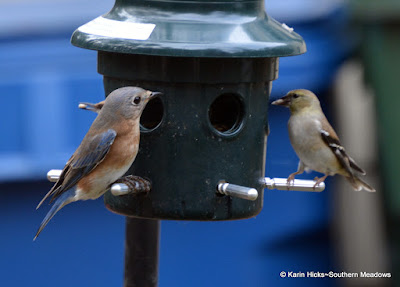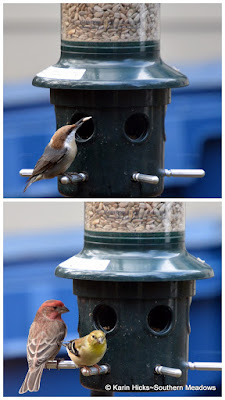Feeding Bluebirds in Winter
Bluebirds typically forage for insects and berries in open country surrounded by trees, but when extreme weather conditions make this more challenging, they may be brave and visit backyard feeders, if you have the right food.
While visiting my sister in North Carolina, during a period of prolonged wet weather, we enjoyed watching bluebirds up close through the kitchen window. All these photos were taken through the glass, as it was very rainy and not possible to shoot outdoors.
At first, the bluebirds frequented the suet feeders. High energy suet that includes hulled sunflower seeds, peanut bits, raisins and cornmeal are good. Their beaks are not designed for cracking open seeds.
Sometimes, they were chased off by the larger red-bellied woodpeckers who would swoop in and command the suet feeder.
The bluebirds were surprisingly brave, venturing into the traffic of other song birds to visit the feeder with hulled sunflower seeds. Bluebirds don't normally eat seeds, so this is a big deal.
Goldfinches, Northern Cardinals, Nuthatches, Carolina Chickadees, and House Finches were constant visitors to this feeder, keeping the stations continuously occupied.
Eating in the company of other birds was something I've never witnessed bluebirds do. Often, they sat at the top of the feeding station patiently waiting for an opportunity to fly down and grab a bite to eat.
And then rush back up on their perch to devour their fare. Even this behavior was new to me as I usually find them very private, only flocking together with their own and even that is rare in our garden.
In normal conditions, it is not necessary to feed bluebirds because they can find the necessary forage in their natural environment. They are very helpful to gardeners, consuming large amounts of insects in spring and summer. If you want to attract more to your garden, include native trees and shrubs that produce berries they like. Some recommendations are Flowering Dogwood, Serviceberry, Viburnum, Cedar, Hackberry, Smooth Sumac, Hawthorn, Pokeberry, Elderberry, Holly, Virginia Creeper and Mistletoe.
In extreme wet or cold winter weather situations or late winter/early spring,when wild berries are gone and insects are scarce, you can make some homemade suet to get them through this time (February to April is most critical). Perhaps you will enjoy watching these bright blue birds right out your backdoor.
Bluebird Dough
Ingredients
1 cup melted lard or beef suet
1 cup peanut butter 2 cups quick oats 2 cups yellow cornmeal 1 cup all-purpose flour
Directions
Melt
lard and peanut butter together on a low burner. Take off heat, and add
remaining ingredients. Spread on a cookie sheet, and allow to cool in the
refrigerator until the mixture is just hard enough to cut into pieces. Store
in freezer bags and use as needed.
|









.png)
